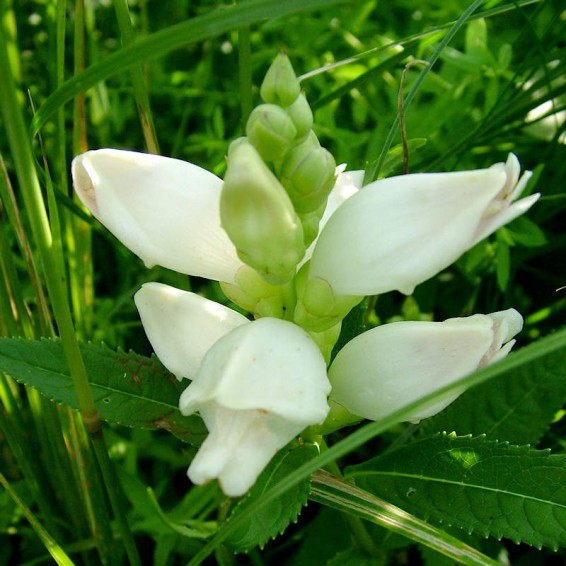Turtlehead Seeds
- HOW TO GROW
- FAST FACTS
- REVIEWS
HOW TO GROW
Sowing: For best results, direct sow in late fall just below the surface of the soil. For spring planting, mix the seed with moist sand and store it in the refrigerator for 100-120 days before direct sowing.
Growing: This plant adapts to clay, sand, or woodland soil with adequate moisture. It must have moist soil for the healthiest growth; watering may be necessary in dry periods. These plants develop rather slowly and may not flower until their second year of growth. Pinch off the growing tips in the spring to help the plant develop compact, bushy growth; this is especially necessary in partially shaded areas, where the plants have a tendency to become tall and weak. Mature plants can be divided in early spring or fall, though they will also spread slowly by rhizomes and reseed themselves. This plant attracts butterflies, hummingbirds, and bees, as well as resisting deer. This plant makes an excellent choice for wetland plantings or the edges of ponds or streams; it also grows well in containers.
Harvesting: Turtlehead has unique blossoms that make lovely cut flowers, and have a vase life of about a week.
Seed Saving: The oval seed pods will begin to turn brown and split open when mature; ripe seed will be dark brown in color. Remove the pods and spread them out to dry completely. Thresh to separate the seed from the pods. Store the cleaned seed in a cool, dry place.
FAST FACTS
Common Names: White Turtlehead
Latin Name: Chelone glabra
Species Origin: US Native Wildflower
Type: Native Wildflowers
Life Cycle: Perennial
USDA Zones: 2, 3, 4, 5, 6, 7, 8
US Regions: Midwest, Northern, Northeast, Southeast
Seeds per Ounce: 94,000
Stratification: Cold/Wet for 16 Weeks
Germination Ease: Stratify 16 Weeks
Sunlight: Full Sun
Height: 48 Inches
Color: Cream
Bloom Season: Blooms Late Summer, Blooms Early Fall
Uses: Cut Flowers, Deer Resistant
Awesome!
Turtlehead Seeds - XL Packet
Received my seeds & they looked great ! Just waiting for them to pop up ! was so happy with my order that I went back and bought some more ! I have pink Turtleheads but the white ones are harder to come by ! These are Beautiful flowers that come back every year and spread !!
DESCRIPTION

HOW TO GROW
Sowing: For best results, direct sow in late fall just below the surface of the soil. For spring planting, mix the seed with moist sand and store it in the refrigerator for 100-120 days before direct sowing.
Growing: This plant adapts to clay, sand, or woodland soil with adequate moisture. It must have moist soil for the healthiest growth; watering may be necessary in dry periods. These plants develop rather slowly and may not flower until their second year of growth. Pinch off the growing tips in the spring to help the plant develop compact, bushy growth; this is especially necessary in partially shaded areas, where the plants have a tendency to become tall and weak. Mature plants can be divided in early spring or fall, though they will also spread slowly by rhizomes and reseed themselves. This plant attracts butterflies, hummingbirds, and bees, as well as resisting deer. This plant makes an excellent choice for wetland plantings or the edges of ponds or streams; it also grows well in containers.
Harvesting: Turtlehead has unique blossoms that make lovely cut flowers, and have a vase life of about a week.
Seed Saving: The oval seed pods will begin to turn brown and split open when mature; ripe seed will be dark brown in color. Remove the pods and spread them out to dry completely. Thresh to separate the seed from the pods. Store the cleaned seed in a cool, dry place.
FAST FACTS
Common Names: White Turtlehead
Latin Name: Chelone glabra
Species Origin: US Native Wildflower
Type: Native Wildflowers
Life Cycle: Perennial
USDA Zones: 2, 3, 4, 5, 6, 7, 8
US Regions: Midwest, Northern, Northeast, Southeast
Seeds per Ounce: 94,000
Stratification: Cold/Wet for 16 Weeks
Germination Ease: Stratify 16 Weeks
Sunlight: Full Sun
Height: 48 Inches
Color: Cream
Bloom Season: Blooms Late Summer, Blooms Early Fall
Uses: Cut Flowers, Deer Resistant
Reviews
Review
Awesome!
Review
Turtlehead Seeds - XL Packet
Received my seeds & they looked great ! Just waiting for them to pop up ! was so happy with my order that I went back and bought some more ! I have pink Turtleheads but the white ones are harder to come by ! These are Beautiful flowers that come back every year and spread !!





